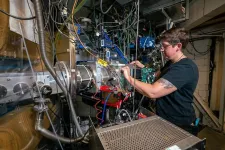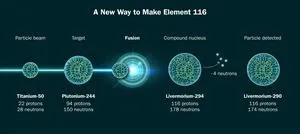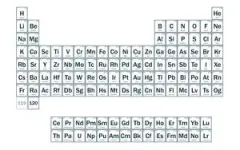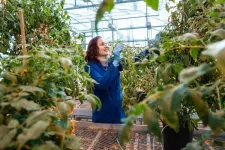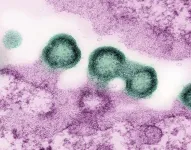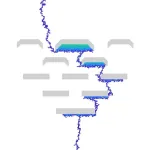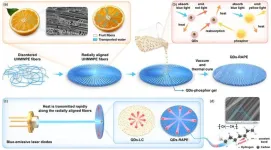Today, an international team of researchers led by Berkeley Lab’s Heavy Element Group announced that they have made known superheavy element 116 using a titanium beam, a breakthrough that is a key stepping stone towards making element 120. The result was presented today at the Nuclear Structure 2024 conference; the science paper will be posted on the online repository arXiv and has been submitted to the journal Physical Review Letters.
“This reaction had never been demonstrated before, and it was essential to prove it was possible before embarking on our attempt to make 120,” said Jacklyn Gates, a nuclear scientist at Berkeley Lab leading the effort. “Creation of a new element is an extremely rare feat. It’s exciting to be a part of the process and to have a promising path forward.”
The team made two atoms of element 116, livermorium, during 22 days of operations at the lab’s heavy-ion accelerator, the 88-Inch Cyclotron. Making an atom of element 120 would be even rarer, but judging by the rate at which they produced 116, it is a reaction scientists can reasonably search for over the course of several years.
“We needed for nature to be kind, and nature was kind,” said Reiner Kruecken, director of Berkeley Lab’s Nuclear Science Division. “We think it will take about 10 times longer to make 120 than 116. It’s not easy, but it seems feasible now.”
If discovered, element 120 would be the heaviest atom created and would sit on the eighth row of the periodic table. It falls on the shores of the “island of stability,” a theorized group of superheavy elements with unique properties. While the superheavy elements discovered so far break apart almost instantaneously, the right combination of protons and neutrons could create a more stable nucleus that survives for longer – giving researchers a better chance to study it. Exploring elements at the extremes can provide insights into how atoms behave, test models of nuclear physics, and map out the limits of atomic nuclei.
Making superheavy elements
The recipe for making superheavy elements is simple in theory. You smash together two lighter elements that, combined, have the number of protons you want in your final atom. It’s basic math: 1+2=3.
In practice, of course, it’s incredibly difficult. It can take trillions of interactions before two atoms fuse successfully, and there are limitations on what elements can reasonably be turned into a particle beam or target.
Researchers select specific isotopes, variants of elements that have the same number of protons but a different number of neutrons, for their beam and target. The heaviest practical target is an isotope called californium-249, which has 98 protons. (A heavier target, such as one made of fermium with 100 protons, would decay too quickly). That means to attempt to make element 120, researchers cannot use their go-to beam of calcium-48 with its 20 protons. Instead, they need a beam of atoms with 22 protons: titanium, something that has not been commonly used in making superheavy elements.
Experts at the 88-Inch Cyclotron set out to verify that they could make a sufficiently intense beam of the isotope titanium-50 over a period of weeks and use it to make element 116, the heaviest element ever made at Berkeley Lab.
Until now, elements 114 to 118 had only ever been made with a calcium-48 beam, which has a special or “magic” configuration of neutrons and protons that helps it fuse with the target nuclei to produce superheavy elements. It had been an open question in the field whether it would even be possible to create superheavy elements near the island-of-stability using a “non-magic” beam such as titanium-50.
“It was an important first step to try to make something a little bit easier than a new element to see how going from a calcium beam to a titanium beam changes the rate at which we produce these elements,” said Jennifer Pore, a scientist in Berkeley Lab’s Heavy Element Group. “When we’re trying to make these incredibly rare elements, we are standing at the absolute edge of human knowledge and understanding, and there is no guarantee that physics will work the way we expect. Creating element 116 with titanium validates that this method of production works and we can now plan our hunt for element 120.”
The plan to make superheavy elements using Berkeley Lab’s unique facilities is included in the Nuclear Science Advisory Committee’s 2023 Long-Range Plan for Nuclear Science.
Feats of engineering
Creating a sufficiently intense beam of titanium isotopes is no easy task. The process starts with a special hunk of titanium-50, a rare isotope of titanium that makes up about 5% of all the titanium in the ground. That piece of metal goes into an oven roughly the size of the final segment of your pinky finger. The oven heats the metal until it starts to vaporize, like the gas coming off of dry ice, at close to 3000 degrees Fahrenheit.
All this takes place in an ion source called VENUS, a complex superconducting magnet that acts like a bottle confining a plasma. Free electrons spiral through the plasma, gaining energy as they are bombarded by microwaves and knocking off 12 of titanium’s 22 electrons. Once charged, the titanium can be maneuvered by magnets and accelerated in the 88-Inch Cyclotron.
“We knew these high-current titanium beams would be tricky because titanium is reactive with many gasses, and that affects ion source and beam stability,” said Damon Todd, an accelerator physicist at Berkeley Lab and part of the ion source team. “Our new inductive oven can hold a fixed temperature for days, keeping titanium output constant and aiming it right at VENUS’ plasma to avoid stability issues. We are extremely pleased with our beam production.”
Every second, about 6 trillion titanium ions hit the target (plutonium to make 116, californium to make 120), which is thinner than a piece of paper and rotates to disperse the heat. Accelerator operators tune the beam to have just the right amount of energy. Too little, and the isotopes won’t fuse into a heavy element. Too much, and the titanium will blast the nuclei in the target apart.
When the rare superheavy element does form, it is separated from the rest of the particle debris by magnets in the Berkeley Gas-filled Separator (BGS). The BGS passes it to a sensitive silicon detector known as SHREC: the Super Heavy RECoil detector. SHREC can capture energy, location, and time, information that allows researchers to identify the heavy element as it decays into lighter particles.
“We’re very confident that we’re seeing element 116 and its daughter particles,” Gates said. “There’s about a 1 in 1 trillion chance that it’s a statistical fluke.”
Plans for 120
There’s still work to be done before researchers attempt to make element 120. Experts at the 88-Inch Cyclotron continue work to prepare the machine for a target made of californium-249, and partners at Oak Ridge National Laboratory will need to craft about 45 milligrams of californium into the target.
“We’ve shown that we have a facility capable of doing this project, and that the physics seems to make it feasible,” Kruecken said. “Once we get our target, shielding, and engineering controls in place, we will be ready to take on this challenging experiment.”
The timing is yet to be determined, but researchers could potentially begin the attempt in 2025. Once started, it could take several years to see just a few atoms of element 120, if it appears at all.
“We want to figure out the limits of the atom, and the limits of the periodic table,” Gates said. “The superheavy elements we know so far don’t live long enough to be useful for practical purposes, but we don’t know what the future holds. Maybe it’s a better understanding of how the nucleus works, or maybe it’s something more.”
The collaboration for this work includes researchers from Berkeley Lab, Lund University, Argonne National Laboratory, Lawrence Livermore National Laboratory, San José State University, University of Strasbourg, University of Liverpool, Oregon State University, Texas A&M University, UC Berkeley, Oak Ridge National Laboratory, University of Manchester, ETH Zürich, and the Paul Scherrer Institute.
###
Lawrence Berkeley National Laboratory (Berkeley Lab) is committed to delivering solutions for humankind through research in clean energy, a healthy planet, and discovery science. Founded in 1931 on the belief that the biggest problems are best addressed by teams, Berkeley Lab and its scientists have been recognized with 16 Nobel Prizes. Researchers from around the world rely on the Lab’s world-class scientific facilities for their own pioneering research. Berkeley Lab is a multiprogram national laboratory managed by the University of California for the U.S. Department of Energy’s Office of Science.
DOE’s Office of Science is the single largest supporter of basic research in the physical sciences in the United States, and is working to address some of the most pressing challenges of our time. For more information, please visit energy.gov/science.
END
